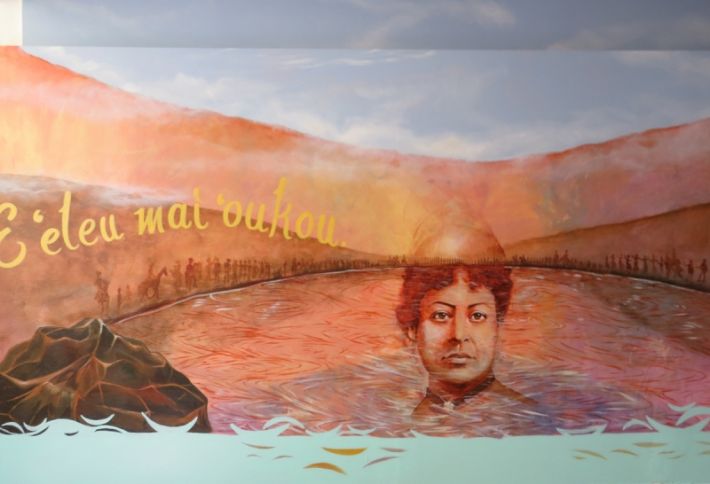By collaborating with community partners like Queen’s Medical Center, KS is aligning its efforts to improve education systems for Native Hawaiians and cultivate a strong cultural identity for the improved well-being of the community.
Ka leo (the voice) is perhaps one of the most powerful and beautiful instruments of all.
Martin Luther King Jr. used it as an instrument for social change; Israel Kamakawiwoʻole used it as an instrument for timeless melodies that empower Native Hawaiians. Artist John “Prime” Hina uses his artistic talents to elevate the leo of his ancestors and the health of keiki at the Queen’s Family Treatment Center (QFTC).
As founder of Urban 808, a community collective focused on improving the quality of life in communities through art, Hina believes murals grounded in Hawaiian values help renormalize Hawaiian culture and improve the health of Hawaiʻi’s keiki.
“By working with others, we get to experience how community success – created by the sharing of our talents and resources – can contribute to collective excellence, and how a firm foundation of cultural identity can restore the well-being of our youth as leaders and contributing members of our lāhui,” said KS Director of Strategy Development Kanakolu Noa.
Dedicated to providing a safe, nurturing environment to facilitate the healing process for the youth of Hawaiʻi and their families, QFTC offers specialized care for children and adolescents with emotional and behavioral disorders. The Piko Project is an effort geared towards growing and strengthening the cultural identity of QFTC’s ʻōpio (youth). The QFTC team is optimistic the project will be part of a cultural art therapy curriculum that allows for positive and meaningful self-expression, while instilling confidence, self-worth and a sense of personal ownership in Hawaiʻi’s youth.
“This partnership with Kamehameha Schools stemed from a conversation about there being an over-representation of Native Hawaiian children there,” said Diane Paloma, director of The Queen’s Native Hawaiian Health Program. “KS, as always, is interested in the well-being of Hawaiian children, and through its Strategy and Innovation Department has begun to look outside the walls of academia.
“This was an important piece to look at because our keiki are the future and if we can reroute them toward good, industrious behaviors, we are in a sense preventing future illness and negative impact to those individuals and their families.”
According to Hina, indigenous art therapy connects Hawaiian values to the children’s healing –something not found within Hawai‘i’s school system.
“There’s still this lack of identity and it has been rewarding to see art be able to help them discover who they are. Imagery brings forth dialogue; dialogue brings forth understanding; and understanding brings forth identity and pride,” said Hina.
Following three months’ work, QFTC’s once-sterile walls are now adorned with floor-to-ceiling murals featuring swaths of color and depicting vibrant stories of Native Hawaiian culture and identity. The mural tells the story of Hawaiian values revolving around the sense of humility and honoring ancestors’ connections to the ʻāina.
At the entrance resides an apu (cup) to greet visitors with ʻawa. The words of “A Mauna Kea O Kalani” run throughout; the fitting mele was written for Queen’s Medical Center founder Queen Emma Kaleleonalani as she made her way up to Lake Waiau on Mauna Kea. Kalo, pūeo, māmane, guiding constellations and the iconic Mauna Kea are all portrayed. Hina notes: “There is a message from Queen Emma that we are only beginning to understand. The imagery didn’t come from us. All we did was just translate it for the kids and staff to understand. It came from the stories of Queen Emma.”
The number of keiki working on the murals ranged from 4 to 15 on any given day. When one of the youth is asked which part of the wall he painted, the beaming young artist replies, “Which part didn’t I work on? I kind of had a hand in all of it.”
Beyond aesthetics, the most telling transformation of the group was the change in the use of dark colors that were chosen by the keiki at the beginning to brighter colors present on the walls today. Staff members have also noted the inclusion of cultural protocol during their interactions with both colleagues and the center’s youth.
“The artwork is a direct result of the process; it’s in the process that we hope to find healing. In the process, we can teach the values such as opening up with piko, mele, pule and, after a while, the artwork becomes irrelevant; it’s more about our day-to-day interactions with each other,” said Hina.
Strategic Plan 2020
SP 2020 is a five-year strategic plan that will guide Kamehameha Schools from 2015 to 2020. The plan marks a starting point toward KS’ vision 2040, which envisions success for all Native Hawaiian learners. These collaborative efforts will help to support Goal 3 of SP2020 – cultivating a strong Native Hawaiian identity towards improving the well-being of the lāhui.
By working with others, we get to experience how community success – created by the sharing of our talents and resources – can contribute to collective excellence, and how a firm foundation of cultural identity can restore the well-being of our youth as leaders and contributing members of our lāhui.
Kanakolu Noa, KS Director of Strategy Development

The murals tell the stories of QMC founder Queen Emma. The creation of the murals helped QFTC children strengthen their cultural identity and rerouted them toward good and industrious behaviors.
TAGS
sp2020 goal 3,
commsuccess
CATEGORIES
Kaipuolono Article, Newsroom, Community Education, Department News, Strategic Planning and Implementation
Print with photos
Print text only










